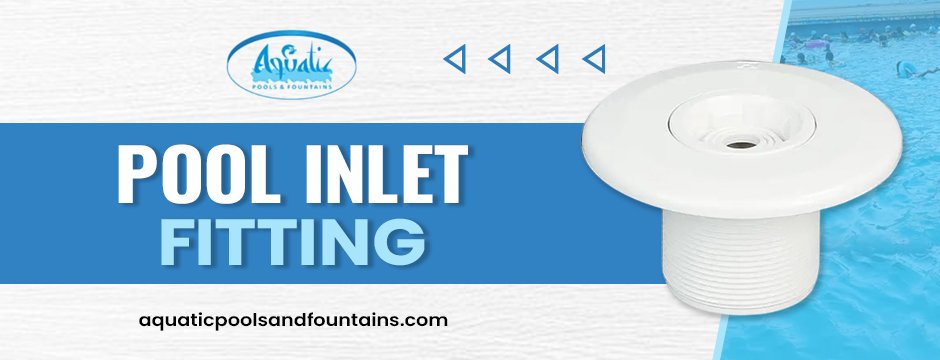Ensuring optimal water flow and efficiency is paramount to maintaining a pristine and inviting swimming pool. One often-overlooked aspect of achieving this is selecting the right pool inlet fittings. These fittings determine water circulation, filtration, and overall pool performance. This comprehensive guide delves into the importance of choosing the correct pool inlet fittings, their impact on water flow and efficiency, and how to make informed decisions to enhance your swimming pool experience.

Pool inlet fittings, also known as return fittings or pool jets, are responsible for directing water back into the pool after it has been filtered through the circulation system. They serve multiple purposes, including:
Improving Water Circulation: Inlet fittings help distribute filtered water evenly throughout the pool, preventing stagnant areas and promoting uniform chemical mixing.
Enhancing Filtration Efficiency: Properly positioned inlet fittings facilitate water movement towards the skimmer and main drain, ensuring effective debris removal and filtration.
Promoting Pool Comfort: By controlling the direction and intensity of water flow, inlet fittings can create soothing water features like gentle streams or invigorating jets, enhancing the overall pool experience.
Selecting the right pool inlet fittings requires careful consideration of several factors to ensure optimal performance and efficiency:
1. Flow Rate:
Choose inlet fittings with adjustable flow rates to customise water circulation based on pool size, shape, and usage.
2. Design and Orientation:
Opt for inlet fittings with adjustable nozzles or directional eyeballs to control water flow direction and spread.
Consider the aesthetic appeal and compatibility with your pool’s design and surroundings.
3. Material and Durability:
Select high-quality, corrosion-resistant materials like stainless steel or UV-stabilized plastics to withstand harsh pool environments and prolong service life.
4. Compatibility with Filtration System:
Ensure compatibility with your pool’s filtration system, including pump capacity and plumbing layout, to maximise filtration efficiency and prevent flow restrictions.
5. Energy Efficiency:
Look for energy-efficient inlet fittings that minimise pump workload and operating costs while maintaining optimal water circulation.
Pool inlet fittings, also known as return fittings or pool jets, are responsible for directing water back into the pool after it has been filtered through the circulation system. They serve multiple purposes, including:
Improving Water Circulation: Inlet fittings help distribute filtered water evenly throughout the pool, preventing stagnant areas and promoting uniform chemical mixing.
Enhancing Filtration Efficiency: Properly positioned inlet fittings facilitate water movement towards the skimmer and main drain, ensuring effective debris removal and filtration.
Promoting Pool Comfort: By controlling the direction and intensity of water flow, inlet fittings can create soothing water features like gentle streams or invigorating jets, enhancing the overall pool experience.
Selecting the right pool inlet fittings requires careful consideration of several factors to ensure optimal performance and efficiency:
1. Flow Rate:
Choose inlet fittings with adjustable flow rates to customise water circulation based on pool size, shape, and usage.
2. Design and Orientation:
Opt for inlet fittings with adjustable nozzles or directional eyeballs to control water flow direction and spread.
Consider the aesthetic appeal and compatibility with your pool’s design and surroundings.
3. Material and Durability:
Select high-quality, corrosion-resistant materials like stainless steel or UV-stabilized plastics to withstand harsh pool environments and prolong service life.
4. Compatibility with Filtration System:
Ensure compatibility with your pool’s filtration system, including pump capacity and plumbing layout, to maximise filtration efficiency and prevent flow restrictions.
5. Energy Efficiency:
Look for energy-efficient inlet fittings that minimise pump workload and operating costs while maintaining optimal water circulation.
Several types of pool inlet fittings are available, each offering unique features and benefits to enhance water flow and efficiency:
1. Standard Wall Fittings:
Basic, fixed-position fittings are typically installed in the pool wall or floor to return filtered water to the pool.
Suitable for standard pool configurations but may need more adjustability and customisation options.
2. Eyeball Fittings:
Adjustable fittings with rotating eyeballs allow users to control water flow direction and dispersion.
It is ideal for directing water towards specific pool areas or creating custom water features.
3. Venturi Fittings:
Innovative fittings that utilise the venturi effect to draw in and mix air with water, creating aeration and enhancing water clarity.
Suitable for improving water circulation and oxygenation in large or heavily used pools.
4. Deck Jets and Water Features:
Decorative fittings are installed along the pool deck or perimeter to create visual and auditory water effects.
Enhance the pool ambience while providing additional water circulation and aeration.
Proper placement and installation of pool inlet fittings are crucial for maximising water flow and efficiency:
Strategic Positioning: Install inlet fittings at strategic locations around the pool perimeter to ensure uniform water circulation and coverage.
Avoid Obstructions: Position inlet fittings away from obstructions like ladders, steps, or pool accessories to prevent flow restrictions and dead spots.
Optimal Depth: Install inlet fittings at the appropriate depth to facilitate efficient water distribution and prevent surface turbulence.
Regular Maintenance: Periodically inspect and clean inlet fittings to remove debris, mineral deposits, or algae buildup that can impede water flow and reduce efficiency.
Choosing the right pool inlet fittings is essential for enhancing water flow, circulation, and overall efficiency in your swimming pool. You can select fittings that meet your pool’s specific needs and preferences by considering factors such as flow rate, design, durability, and compatibility. Whether you opt for standard wall fittings, adjustable eyeball fittings, venturi fittings, or decorative water features, prioritise quality, functionality, and energy efficiency to optimise your pool experience.
Investing in high-quality pool inlet fittings and ensuring proper placement and installation will improve water circulation and filtration and enhance the aesthetic appeal and enjoyment of your pool. By making informed decisions and implementing best practices, you can create a safe, comfortable, and inviting swimming environment for yourself, your family, and your guests to enjoy for years.
Remember, when choosing pool inlet fittings, prioritise functionality, durability, and compatibility to enhance water flow and efficiency and, ultimately, elevate your pool experience.
For a wide selection of premium pool inlet fittings and expert advice on optimising your pool circulation system, visit Aquatic Pools & Fountains L.L.C today!